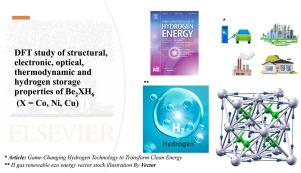Be2XH6 (X = Co, Ni, Cu)结构、电子、光学、热力学和储氢性能的DFT研究
IF 8.3
2区 工程技术
Q1 CHEMISTRY, PHYSICAL
引用次数: 0
摘要
通过第一性原理计算,探讨了Be2XH6 (X = Co, Ni, Cu)双氢化物钙钛矿的结构、电子、光学、热力学和储氢性能。通过能量体积曲线优化得到Be2CoH6、Be2NiH6和Be2CuH6的晶格常数分别为5.90 (Å)、5.98 (Å)和6.14 (Å)。声子色散曲线证实了除Be2CuH6外双钙钛矿的动态稳定性。在更高的有限温度下,通过从头算分子动力学计算进一步测试了稳定性。能带结构表明价带和导带之间不存在能差,反映了双氢化物钙钛矿的金属性质。Be2NiH6的最高静态介电常数。压下热力学性质反映出随着施加温度的升高,德拜温度降低。然而,熵和比热容随着外加温度的升高而增加。Be2CoH6、Be2NiH6和Be2CuH6的重量储氢容量Cωt%分别为6.80%、6.82%和6.47%。高稳定性和大的重量储氢容量使这些材料在储氢应用中具有突出的应用价值。本文章由计算机程序翻译,如有差异,请以英文原文为准。

DFT study of structural, electronic, optical, thermodynamic and hydrogen storage properties of Be2XH6 (X = Co, Ni, Cu)
First principles calculations are performed to explore structural, electronic, optical, thermodynamical and hydrogen storage properties of Be2XH6 (X = Co, Ni, Cu) double hydride perovskites. The lattice constants of Be2CoH6, Be2NiH6 and Be2CuH6 are optimized from energy volume curve and noted 5.90 (Å), 5.98 (Å) and 6.14 (Å) respectively. The phonon dispersion curve confirms the dynamic stability of under study double perovskites except Be2CuH6. The stability is further tested at higher finite temperatures via ab-initio molecular dynamic calculations. The energy band structure shows the existence of no energy difference between valance and conduction band which reflects the metallic nature of double hydride perovskites. The highest static dielectric constant noted for . The under pressure thermodynamic properties reflect that the Debye temperature is reduced with increasing the applied temperature. However, an increase in entropy and specific heat capacities can be noted with the increase of applied temperature. The gravimetric hydrogen storage capacity of , and are 6.80%, 6.82% and 6.47% respectively. High stability and large value of gravimetric hydrogen storage capacity makes these materials prominent for utilization in hydrogen storage applications.
求助全文
通过发布文献求助,成功后即可免费获取论文全文。
去求助
来源期刊

International Journal of Hydrogen Energy
工程技术-环境科学
CiteScore
13.50
自引率
25.00%
发文量
3502
审稿时长
60 days
期刊介绍:
The objective of the International Journal of Hydrogen Energy is to facilitate the exchange of new ideas, technological advancements, and research findings in the field of Hydrogen Energy among scientists and engineers worldwide. This journal showcases original research, both analytical and experimental, covering various aspects of Hydrogen Energy. These include production, storage, transmission, utilization, enabling technologies, environmental impact, economic considerations, and global perspectives on hydrogen and its carriers such as NH3, CH4, alcohols, etc.
The utilization aspect encompasses various methods such as thermochemical (combustion), photochemical, electrochemical (fuel cells), and nuclear conversion of hydrogen, hydrogen isotopes, and hydrogen carriers into thermal, mechanical, and electrical energies. The applications of these energies can be found in transportation (including aerospace), industrial, commercial, and residential sectors.
 求助内容:
求助内容: 应助结果提醒方式:
应助结果提醒方式:


